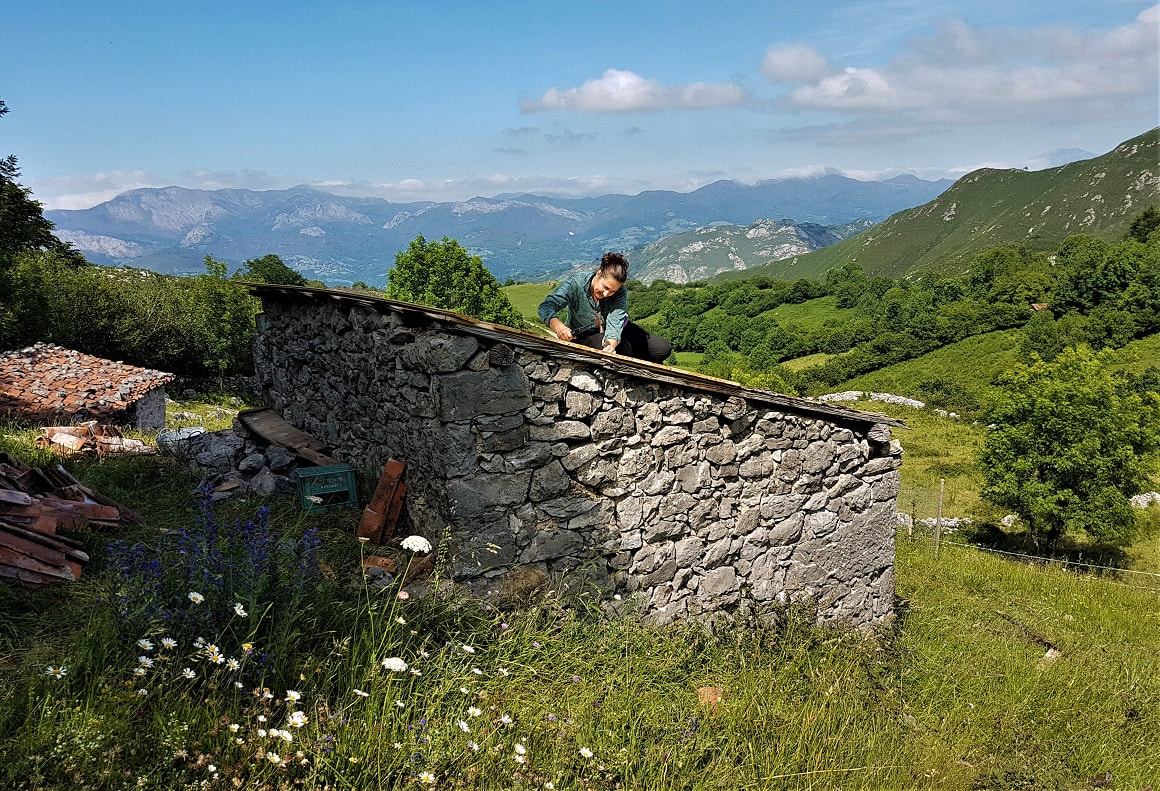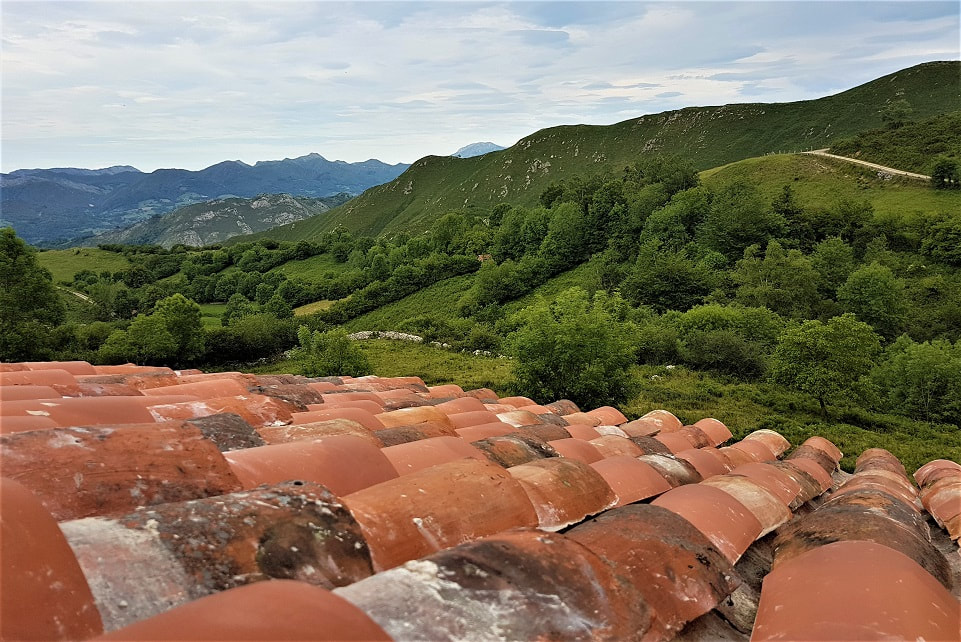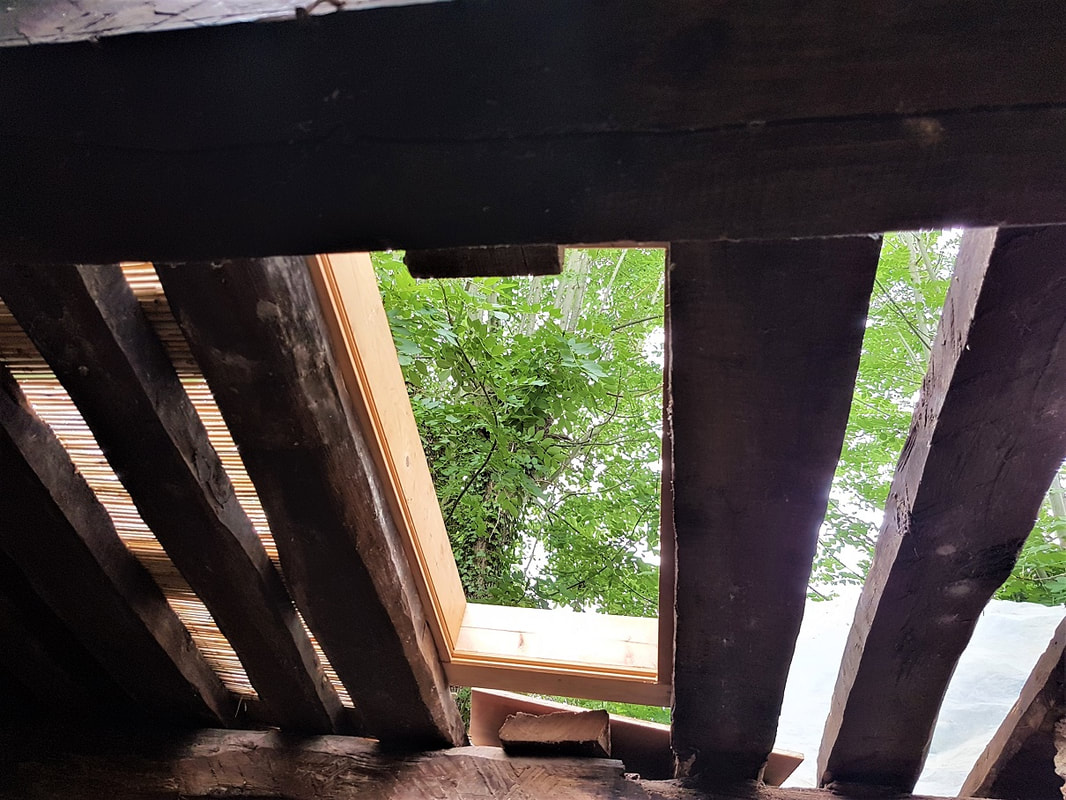|
It’s been a slog. S L O G. With each letter in that word turning into a week-long endurance marathon where I dodge wind, mist, and rain in the pursuit of a roof or two. Some building tasks are simply not one-person affairs. Roofing is one of them. Now, I’m not going to lie. Should you be imagining vast arenas of canopy, I must come clean: My roofs are tiny, 4 x 4 m arrangements perched upon nobbled stone huts less than three metres off the ground. Hardly castles. But what the structures lack in size, they make up for in complication. I’m basically hunkering down in a museum here in northern Spain. The exteriors must remain loyal to history. And Spanish history has a preoccupation with tejas curvas. Curvy tiles. For many reasons, I had to wait until mid-June before I could take apart the first roof. Finally, after a week of cold, slimy fog, there was an opening. The sky briskly swept the clouds off into the distance, and changed into a vast blue overland where the only visible limits were the mountaintops themselves. The sun graced the sierra with his feisty presence. I took my cue. Throwing together a scaffold from a plank and a couple of beer crates, I jumped out of my mind and into reality. This was altogether a good thing as I’d been thinking this darn roof through for months. And I know only too well that ninety percent of thinking is pointless, because the moment you actually begin work in the physical world, everything changes. Foreseen problems evaporate, unforeseen snags appear. The mind has never got it covered. Only the soul can do that. So it was that I began yanking off those mottled terracotta semicircles. And oh with what zest! Quickly the roof transformed into a bare skeleton of ancient wood. True, I did notice that the tiles turned artfully heavier the further down the sharp incline I progressed. Still, it all seemed simple enough. Little did I know as I carefully stacked the old tejas against my herb garden. Little did I know. Three days later the weather was still holding up, but I was so physically broken that I could hardly climb in my van at night. Even so, my spirit was alive and kicking, because I’d managed to single-handedly raise the roof 15 cm for a couple of discreet slit windows. I’d repaired all the rafters, extended the roof a little, and pinned the waterproofing bitumen in place too. Without power tools. Yup, I was making it happen. All. By. Myself. And I loved it. I loved breaking through the pain and exhaustion barriers, the mental barriers. My muscles were growling in content. Because it’s only when we stretch beyond our self-imposed limitations that we grow. My cow farmer neighbour Quilo popped round. He’s a garden gnome of a chap with an apple of a face and twinkly eyes. Like my other sidekick Celal in Turkey, he’s clearly partial to a tipple here and there, and his nose is bright red as a result. “Es muy impressionante!” Quilo said at least three times as he inspected the rafters. I grinned from ear to ear, because I thought I had it in the bag. All that remained were those tejas flipping curvas. In the old days, tejas curvas were placed on round poles and covered in rocks to prevent them from being ripped off in the wind. But that’s not an especially stable way of anchoring a roof if you happen to be a human living in it, rather than say a cow – which is the kind of inhabitant my stone huts are designed for. “Vale. Como hacemos las tejas?” I asked. “How? How do they work?” Quilo stooped, grabbed a few tiles, and showed me how to lay them using mortar. Which was fortunate, because I didn’t have a clue. “But mortar is hard,” he said. “Use the spray glue. Much better, much faster, and not that expensive. Es mucho mas facile!” I wrinkled my nose disdainfully. Quilo shrugged. “If you need any help, just ask,” he said, knowing full well I wasn’t going to in a million, zillion years. The next day I peered out of my van to see a champignon horizon. Darker puffballs lurked to the west, and I knew it was only a matter of time before precipitation came slinking back. So without taking my statutory day off, I mixed some limecrete to use as mortar, stacked up some tiles on the edge of the roof and clambered up in a groaning, flopping seal-like effort. It hadn’t been this hard in the beginning, surely... Thus the torture began. It was an exacting inquisition by terracotta. As I perched on the rack of the roof, I sensed my knees and ankles groan. Then the first wet slap of bad news landed with a splat upon one of the tile tops. They were clearly going to need much more mortar than I had anticipated, and mixing the mortar was exhausting. The ratchet turned tighter. The next issue was the pitch of the roof, which unless you happened to be a contortionist, contrived to throw every joint and ligament out of line. Then there were the irritating corrugated bumps of the bitumen which were impossible to walk in shoes without breaking. So I took my shoes off and hobbled about instead, which was hideously uncomfortable. But worst of all was the way I would slap on the mortar, lay a tile, then move to the next one, only to nudge the first one out of place. With limecrete mortar, the initial suction is vital, otherwise the tile no longer sticks. Inhale. Exhale. Breathe. Even once I had got all of the above working, the thing was still looking an utter mess unless I wiped the head of each tile with a sponge and water. I managed a row, and was all but crippled by it. Then of course I was out of tiles. Or water. Or mortar. And had to climb down and up and down and up that roof to fetch them. The first day of tiling ground to a dissatisfying halt. Daylight made a slow crawl off my land and an ominous spread of mist sidled into its place. Plenty of empty roof was left to gloat at me. I’d managed about four rows of tiles. But worst of all I’d made a pig’s ear of it. It took three days of solid teeth-gritting work to both lay those tiles and clear my aesthetic bar. By which time I had decided the roof and I were at war. I vowed I’d never do it again. But then, what do you know… a week went by. Then another. A nice dry spell slid into the region, with the slopes glittering and gleaming with promise. Before I knew it, I was gamely pulling off the tiles of cabaña number two. Now that I’d got the hang of this roofing lark, I figured I could experiment a little. I decided to add both insulation and a skylight. Because hey, why make your life easy when you can completely overextend yourself? Losing the Will I began that roof three weeks ago. If I thought the first roof was a war, then this second one is a siege. For the first time ever since I began building, I’ve felt my willpower begin to leak away. The whole process is simply so hard, slow, and tedious. Willpower is, in my experience, the linchpin of making anything happen, but it’s something most moderns are not taught how to cultivate. I’m lucky, I have a nice, tough congenital streak of the stuff, but even I can lose momentum after a while. What is willpower? When I sit and sense inside, I feel it as a gleaming ladder of belief leading to a dream. Sometimes the body falters, sometimes the mind loses its grip, but some part of us has to stay on the ladder even if we’re resting. It’s the conviction that you will reach the end if you can just pull yourself up another rung. And then one more again. You may need to pause. You may need to call in help. You may need to modify your vision. But you do keep moving, however slowly. Gaian Power One day I fell in the skylight. My nose was bashed, long scrapes ran down my arms, my legs were bruised and battered. It shook my resolve. So I abandoned the roof to its fate, drove to the beach and bought ice-cream – always a panacea for a bad day. But within two days I was climbing that scaffold again. Within three, the grazes and cuts were disappearing. Within a week, the bruises were fading too. I stared in the mirror at my nose, searching for clues of the injury. Miraculously there were none. Our flesh is Gaian. It adapts and strengthens and grows in the most incredible ways. If allowed to recuperate, it regenerates. It’s just one of the miracles of Earth. Nothing humans have come up with in the history of engineering possesses this magical capacity for self-repair and regeneration. And it’s this Gaian power we have to plug into when we’re building a house, a life, or a new world. For me, because nature embodies this power, it’s the place I turn to for inspiration. So, I sat in the folded crook of my ash tree’s trunk as the weather churned in and out. Mist, rain, sun, wind. I gazed into the meadow and listened. “Step by step”, the ash said as the wind invigorated her slender leaves. “You can do this. You can get there. Today just get the insulation down.” So I did. Then the sheets of bitumen. Then the skylight. Finally last week I was struggling so hard to find motivation, I called on my friends, because I knew if someone else turned up, it would push me to work. Today the end is in sight, and even though it has tested my endurance to the limits, I know come autumn I’m going to bask under that skylight. Come winter, I’m going to sing within that insulation too. Heck yes, I’ll be supping Rioja in a T shirt while I gaze up at the stars. The effort has its own reward. Of course, this end is only a beginning, the beginning of one new world. But I know that once the roof is on, the fun begins, because everything else from the kitchen sink to the plaster is a game. There’s a reality check though, and it can’t be avoided. You can’t play games without a roof over your head, without a dry place to sleep, and a warm place to cook and wash. You can only wing it so far. Yes, building the basics is a slog. But it’s a one-time payment. And once it’s made, I know from experience, you dance and live the dream. Yet there’s something even more valuable and interesting still. Once you’ve held onto the rungs of willpower without giving up and letting go, once you’ve climbed step by step to the roof of your idea – no matter how slowly – you know you can do it again. Because the ladder of conviction is not some man-made, plastic piece of trash. It’s Gaian. And every time it’s used, it becomes stronger and longer and more powerful. It takes you to the stars. Special call out to Sophie Hunter and Dianne and Bismil Gungor, who donated their sweat and time to help me with the dreaded tiling when I was running out of steam.
Thank you too to our lovely clan of Mud Sustainers and patrons on Patreon! Their contributions cover the web platform costs, 10 GB of off-grid internet, the email list, hosting, and the now vital virtual assistance from the reliable and efficient Melissa. If you are enjoying The Mud Home posts, please consider making a pledge to support it. For just $2 a month you have email priority, access to my private news feed where I share my more intimate woes and victories. Plus a monthly patron-only video from my land.
5 Comments
|
Atulya K Bingham
Author, Lone Off-Gridder, and Natural Builder. Dirt Witch
"Reality meets fantasy, myth, dirt and poetry. I'm hooked!" Jodie Harburt, Multitude of Ones.
Archives
November 2022
Categories
All
|










 RSS Feed
RSS Feed


